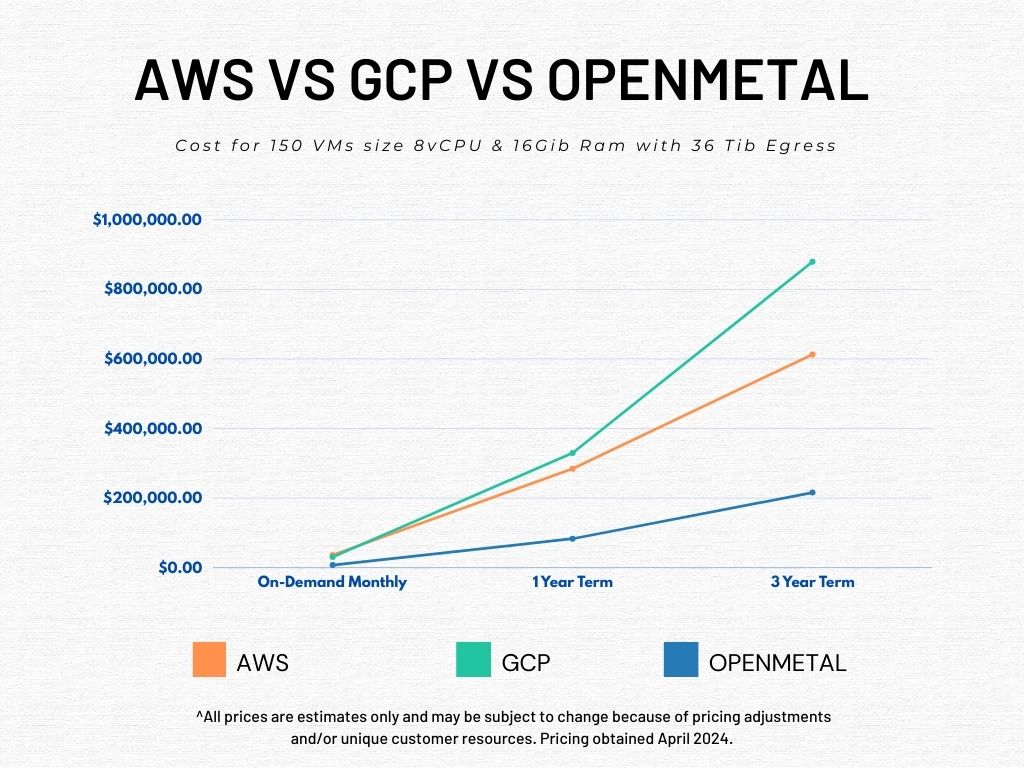
^All prices are estimates only and may be subject to change because of pricing adjustments and/or unique customer resources. Pricing obtained April 2024.
*Config summary: Tenancy (Shared Instances), Operating System/Software: Free, Number of instances: 593, Provisioning Model: Regular, GCP instance (E2-medium), Committed Use Discounts applied, Internet Egress (Standard Tier: 36,000 GiB), Persistent Disk (Accompanying): Zonal SSD PD 40 GiB), Northern Virginia
When it comes to cloud computing, AWS pretty much established the cloud scene and has since maintained its position as a key player in cloud computing. Being one of the oldest cloud providers, AWS has over time developed an extensive suite of offerings and most cloud tools can be integrated into your AWS cloud. It’s an excellent choice for businesses with small workloads that are now tapping into the power of clouds. Public clouds were designed to allow businesses to reap the benefits of cloud technology without having to assume the cost of an entire cloud.
However, like with all products, buying retailed packaged slices is significantly more expensive than a bulk wholesale cloud. And as your workloads grow and you expand your cloud infrastructure your bill grows significantly. Before you know it, your infrastructure solution is no longer cost effective. There are several reasons why AWS customers experience bill shock, here are some of the most common
Reasons for Unpredictable AWS Costs:
Data Transfer Fees is one of the main reasons for AWS bill shock. AWS offers generous allowances for data ingress, however the costs associated with outbound data transfer—especially across regions or to external networks—can quickly spiral out of control. This is particularly true for applications with high data transfer requirements, such as media streaming platforms or data-intensive analytics workloads.
Idle Resources: instances, storage volumes, and other AWS assets that remain active but underutilized. This can be the result of oversight, misconfiguration, or shifting workload demands. We’ve all seen posts of customers who forgot to turn off resources and were shocked by the bill it accrued. These idle resources accrue costs without delivering value.
Complex Pricing Models: while the AWS pricing structure is comprehensive, it can also be a double-edged sword for customers. The multitude of services, pricing tiers, and usage-based billing models can lead to confusion and miscalculations. Add-ons such as data transfer, storage snapshots, and premium support tiers further complicate the pricing landscape, making it challenging for IT decision makers to anticipate and control expenses accurately.
Being surprised by cloud cost overruns when your budget is already stretched thin by high infrastructure costs can put you in a difficult position. Unpredictable costs can undermine the foundation of budgeting, forecasting, and overall financial management. When faced with cloud cost overage, strategic decisions need to be made. You can make cut backs: reduce resources for your projects, cut back on personnel, or take a FinOps approach to develop a comprehensive solution for your business.
In this blog we will explore cost-effective alternative cloud solutions to Amazon Web Service. Cost-effective here aligns with FinOps principles on managing infrastructure costs. Let’s first briefly outline those.
What is FinOps?
FinOps is a cultural shift that encourages collaboration between internal operational teams to optimize the costs of cloud services. This allows the efficient use of cloud resources to maximize the value delivered to an organization’s customers.
Principles for Optimizing Cloud Spending
The principles of FinOps are grounded in the ethos of efficiency, optimization, and accountability. Central to the FinOps approach is the concept of “value for money”—ensuring that every dollar spent on cloud services delivers tangible business value. Key strategies used in a FinOps approach to managing infrastructure costs include:
Right-sizing: Optimizing resource allocation to match workload demands and eliminate waste.
Visibility: Everyone who makes decisions that affect cloud costs need to gain transparency into cloud spending and usage patterns. This can be accomplished through monitoring and reporting.
Accountability: It is important to establish clear ownership and accountability for cloud costs within cross-functional teams.
Automation: With the complexities of a multi cloud system, it’s difficult to manually make changes as needed. It’s wise to leverage automation tools and scripts to streamline provisioning, scaling, and cost management processes.
Continuous Improvement: FinOps is an ongoing process that pivots and alters as the needs of the organization or costs of providers changes.
Exploring GCP as an Alternative to AWS
If you love public cloud and want to stay with a public cloud provider, then Google Cloud Platform will certainly be one of the first options that pop into your head when you think of alternatives to AWS.
Now, whether AWS or GCP is the right solution for you business will depend on your business’ needs.
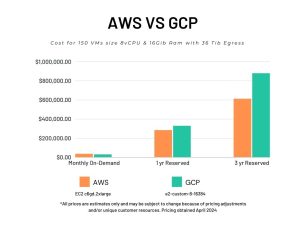
^All prices are estimates only and may be subject to change because of pricing adjustments and/or unique customer resources. Pricing obtained April 2024.
*Config summary: Operating System/Software: Free, Number of instances: 150, Provisioning Model: Regular, GCP instance (e2-custom-8-16384), AWS Instance (EC2 c6gd.2xlarge) Committed Use Discounts applied, Internet Egress (Standard Tier: 36,000 GiB), Persistent Disk (Accompanying): Zonal SSD PD 40 GiB), Northern Virginia
Services
AWS has an extensive suite of services, offering a range of options for businesses.
However, GCP is continually expanding its service catalog to cater to businesses of all sizes.
Support
AWS boasts a larger support team, to attempt to keep up with support requests from their many customers. GCP’s support team is reputed to be highly responsive.
Security
Both AWS and GCP prioritize security, but like all systems they’re not invulnerable. According to the New York Times, last year it was discovered that a former AWS engineer used her knowledge to exploit vulnerabilities in Capital One’s servers and access over 100,000 customers’ data and even used the servers to mine for cryptocurrency.
Community
AWS has a well-established and thriving community, providing a wealth of resources, including tutorials, documentation, and support forums.
GCP’s community is growing, it has already fostered a large and active user base that can provide valuable insights and assistance.
Alternative Cloud Solutions
Many businesses need a cost effective alternative to public cloud but cannot lose the benefits that they enjoy from using the public cloud model. On-demand resources and hardware management takes quite the load off your internal technical teams. They do not need to manage hardware and you can quickly access additional resources with the click of a button. Let’s explore a cost-effective hosted private cloud infrastructure built using the open source software OpenStack.
Exploring OpenStack by OpenMetal as an Alternative to AWS
OpenMetal’s On-Demand OpenStack provides hosted private clouds that you can deploy in under 1 min. These cloud cores consist of three servers, are powered by OpenStack, backed by Ceph, and provide organizations with full control over their cloud infrastructure.
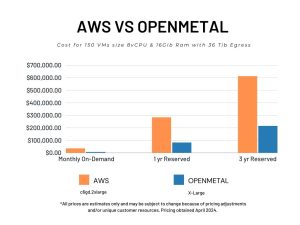
^All prices are estimates only and may be subject to change because of pricing adjustments and/or unique customer resources. Pricing obtained April 2024.
*Config summary: Operating System/Software: Free, Number of instances: 150, Provisioning Model: Regular, OpenMetal V2.1 XL Hosted Private Cloud, AWS Instance (EC2 c6gd.2xlarge) Committed Use Discounts applied, Internet Egress (Standard Tier: 36,000 GiB), Persistent Disk (Accompanying): Zonal SSD PD 40 GiB), Northern Virginia
Service
AWS has an extensive suite of services, offering a range of options for businesses.
OpenMetal clouds are built with open source software which means that you have a multitude of free tools and services you can implement within your cloud.
Support
AWS boasts a larger support team. However, OpenMetal, though operating with a smaller team, provides customers with direct access to Tier 3 support engineers. There’s no need to wait for escalation, you can directly contact your support agent.
Security
While AWS provides you with many tools to secure your infrastructure, their code is proprietary and confidential. Lack of access to the code can leave you vulnerable to weaknesses that you have no way of knowing exist. With open source code you have complete access to all code to customize and improve as needed to secure your infrastructure.
Community
AWS has a well-established and thriving community, providing a wealth of resources, including tutorials, documentation, and support forums.
OpenMetal delivers unaltered OpenStack so you can easily tap into the large and buzzing open source community.

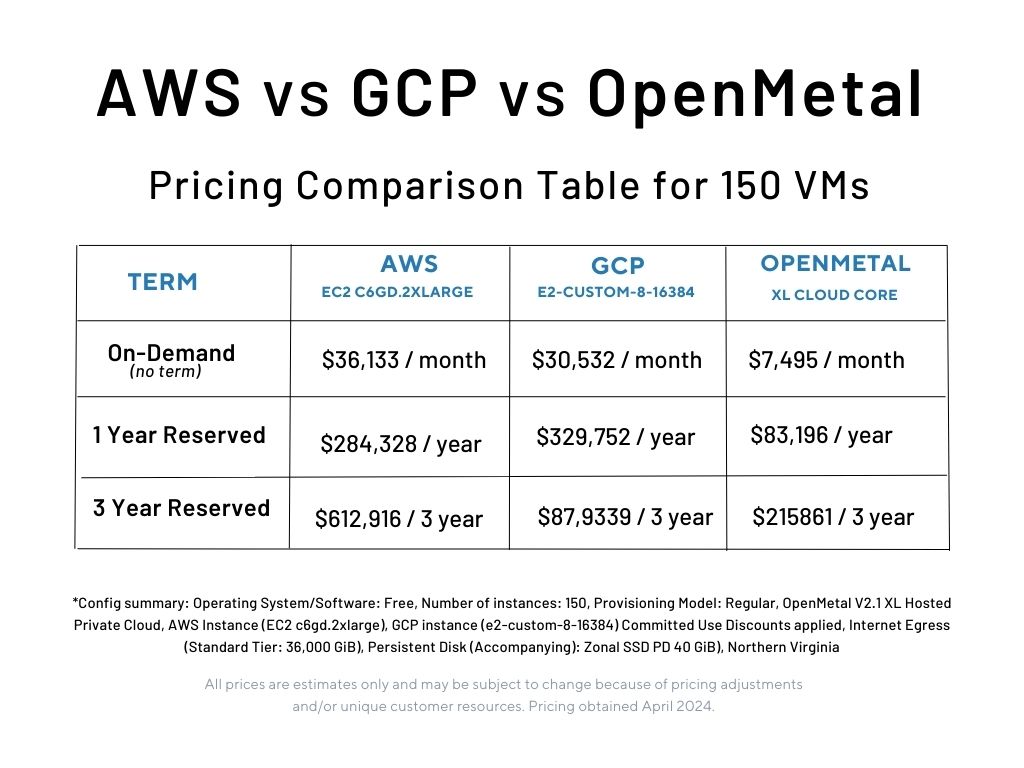
^All prices are estimates only and may be subject to change because of pricing adjustments and/or unique customer resources. Pricing obtained April 2024.
*Config summary: Operating System/Software: Free, Number of instances: 150, Provisioning Model: Regular, OpenMetal V2.1 XL Hosted Private Cloud, AWS Instance (EC2 c6gd.2xlarge), GCP instance (e2-custom-8-16384) Committed Use Discounts applied, Internet Egress (Standard Tier: 36,000 GiB), Persistent Disk (Accompanying): Zonal SSD PD 40 GiB), Northern Virginia
By transitioning sizable workloads to OpenMetal On-Demand Private Clouds, you can significantly reduce your cloud expenses. This shift will allow you to retain the convenience of being able to scale resources as needed and avoid hardware management. Plus, even without committing to a term contract, you can expect savings of around 60% compared to what public cloud providers offer.
AWS vs GCP vs OpenMetal Recap
Amazon Web Service
Pros:
-Global Reach.
-Wide Ranges of Services.
-Security.
Cons:
-Cost, not only is AWS expensive but the billing structure can be confusing.
-Complexity, it can be difficult to get started on AWS without engineers trained to use the platform.
OpenMetal
Pros:
-Pricing, significantly lower than mega cloud providers.
-Control, root level access to configure your cloud.
-Support, direct access to OpenStack Engineers.
Cons
-Higher starting cost.
-Complexity, better suited for teams with OpenStack training.
Google Cloud Platform
Pros:
-Innovation.
-Performance, GCP services are designed to deliver high levels of performance and reliability.
-Pricing, lower prices than AWS.
Cons:
-Limited market share.
-Complexity, GCP can be complex to use, especially for businesses that are new to cloud computing.
What sets OpenMetal apart from public cloud?
OpenMetal offers instant availability of computing resources, similar to public clouds. However, OpenMetal distinguishes itself through the private nature of its cloud cores. Each hyper-converged cloud core, comprised of three servers, is exclusively allocated to a single tenant.
As a tenant, you enjoy root level access to your dedicated cloud, empowering you to fine-tune both hardware and software according to your precise requirements. With OpenMetal, you have full authority over your infrastructure, granting you the freedom to implement custom security measures as per your preference.
Currently, OpenMetal clouds are running on OpenStack Yoga and Ceph Quincy. All OpenStack and Ceph updates as well as hardware management is handled by the OpenMetal engineering team.
While AWS and GCP have secured their position on the cloud front, we’re not paying extra for names and reputation. We’re looking at product performance and support. And after careful examination, I’m not convinced that AWS and GCP provide sufficient additional value to justify their significantly higher price tag.
But you don’t have to take my word for it! Experience the power, performance and efficiency of an OpenMetal On-Demand OpenStack Cloud for yourself.
AWS Alternatives
For a more detailed layout of exploring OpenMetal Cloud Cores as an alternative to AWS, visit our AWS Alternatives page. There you can look at various comparisons based on budget size, VM specs, and customer stories.
Google Cloud Alternatives
For a more detailed layout of exploring OpenMetal Cloud Cores as an alternative to GCP, visit our Google Cloud Alternatives page. There you can look at various comparisons based on budget size, VM specs, and customer stories.
More on the OpenMetal Blog…
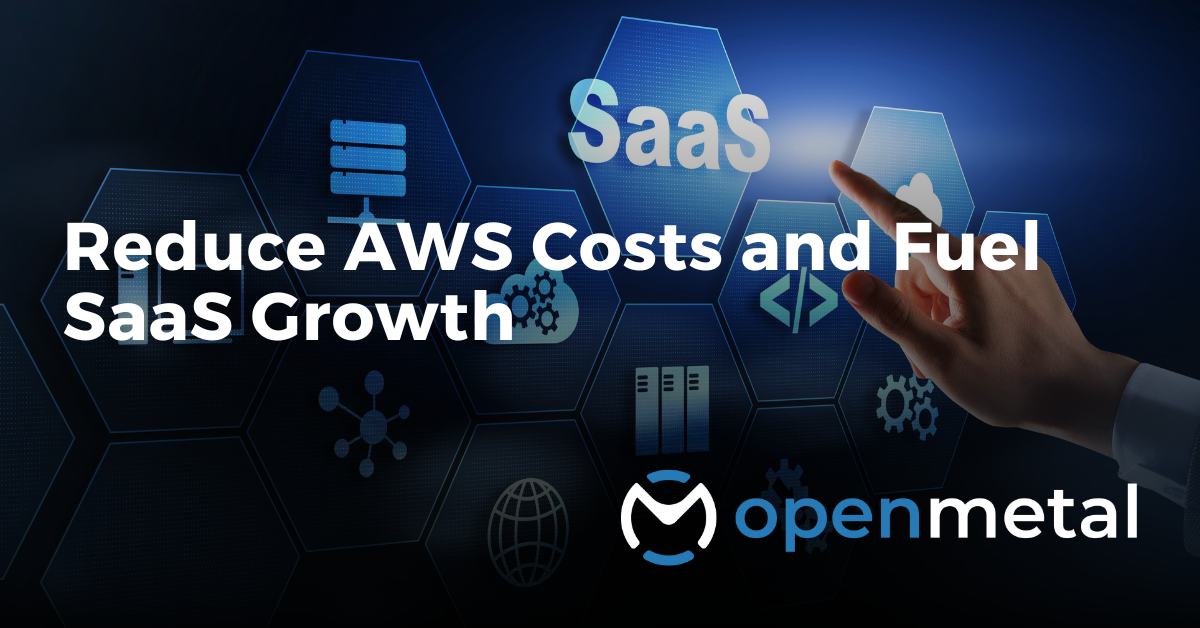
Reduce AWS Costs and Fuel SaaS Growth
When SaaS providers consume large amounts of public cloud, a move to a hosted private cloud may reduce current AWS costs up to 50%. This can…Read More
Explore alternatives to OpenStack – Apache CloudStack, VMware vCloud, Proxmox, Google Cloud Platform and Amazon Web Services. OpenStack is an open source platform composed of several independent…Read More
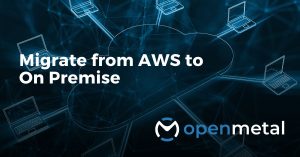
Migrate From AWS to On Premise
Ready to explore the advantages of on-premise clouds alongside Todd Robinson, the President of OpenMetal? Under his guidance, delve into the details and acquire valuable insights on establishing your very own on-pre…Read More
Test Drive
For eligible organizations, individuals, and Open Source Partners, Private Cloud Cores are free to trial. Apply today to qualify.
Subscribe
Join our community! Subscribe to our newsletter to get the latest company news, product releases, updates from partners, and more.



































